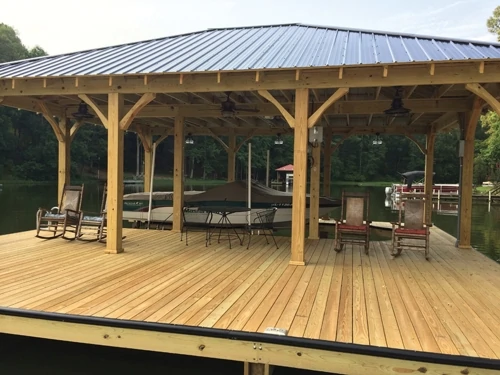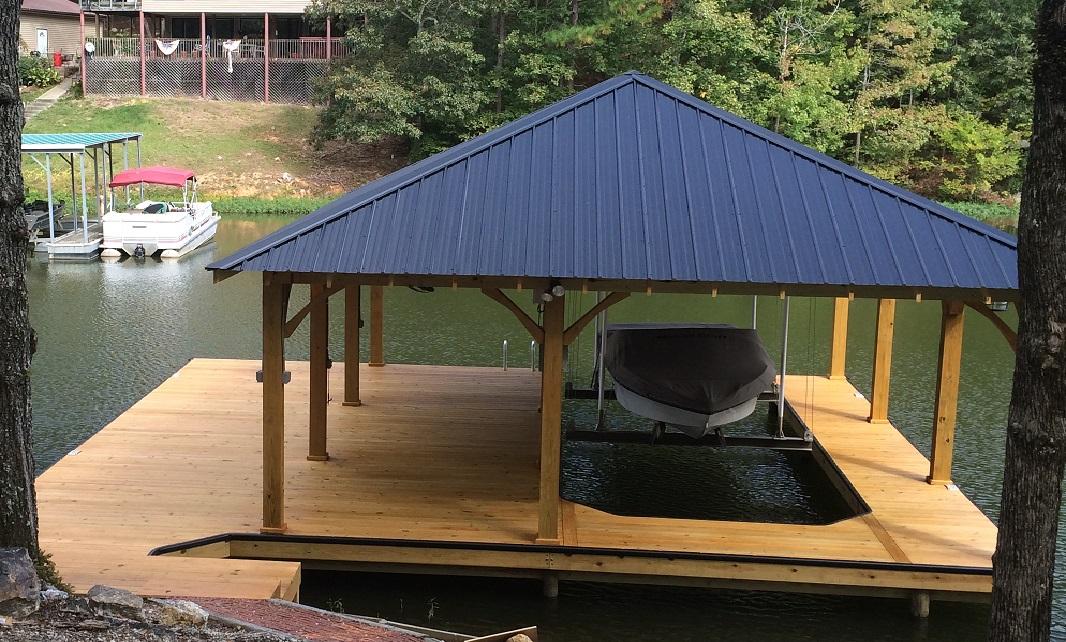Learn the basics from professionals with years of experience.
By Matt Weber
A dock is essentially a deck built on piles in the water, and a boathouse is a specialized structure built on top of the dock. Whereas building a deck is a popular project for serious do-it-yourselfers, building a boathouse—especially a big one—requires heavy-duty machinery like a barge mounted with a huge winch-operated pile driver. Although much of this project is outside the realm the do-it-yourselfer, we thought our readers would be interested to see how it’s accomplished. This dock was built by a top notch crew of professional dock builders on Logan Martin Lake in Alabama.
The Right Materials
You can’t simply stick any old wood near the water and expect it to hold up. For this project the dock-builders at Tradesman Co. of Pell City, Alabama, chose lumber from the Everwood Treatment Company, which uses Wolmanized® copper azole preservative treatment. This No. 1 grade hand-picked wood was treated with micronized CA-C for Ground Contact as well as for Freshwater Immersion, meeting all building code requirements. It’s a great building material for docks, decks, retaining walls, fences, picnic tables, planter boxes, walkways, sill plate and structural members. The lumber’s S4S designation means it’s sanded on four sides for a finished, professional look. And, Wolmanized Outdoor® wood has earned the Good Housekeeping Seal, has been certified by Home Innovation Research Labs as meeting requirements for termite-resistant materials in the National Green Building Standard™, and has been verified by the internationally recognized EcoSpecifier. It comes with a limited warranty for most residential applications and, to top it off, it costs less than alternatives such as tropical hardwoods and artificial wood.
By using hand-picked lumber, the dock owner gets only the best looking boards with fewer knots and imperfections from the lumberyard.
Bring on the Barge
The first construction crew arrives at the jobsite by water. One boat carries the piles that will support the boathouse, and another one carries the crane-like pile driver to install them.
One at a time, a steel cable is used to hoist a pole from the stockpile, and the barge is used to float it over to its intended location. The crew spots the layout and lowers pole-anchors to hold the barge steady on the lake floor.
A worker positions the post, plumbs it up, and the crane operator drops a doubled iron plate onto the top to hammer it down.
Before seeing this in action, I was curious: Do the installers cut the end of the piles at some sort of sharp angle for easier entry into the lake bottom? The answer is no. The workers plant the blunt end of the massive round poles right where they want it, and the pile driver hammers it in with sheer brute force.
Using string-lines to follow layout, the barge crew lines up all the posts necessary and drives them in position with the mighty anvil.
It’s pretty cool to watch.
The remainder of the dock is erected much like a well-built deck, with a system of beams (or girders), joists and 5/4 deck boards. Of course, one of the primary differences is that you have to swim to the work. Thank goodness for reliable cordless tools with lithium-ion batteries.
As with any framing project, the structural components have to stay dead-on layout, completely plumb and square. To keep everything in place during assembly, the crew uses straps to pull pieces together or spacer bars to push them apart as needed while they sink the fasteners.
With the doubled beams in place, next comes the joist system built from 2x10s.
The joists are first toe-nailed over the beams. The crew then goes back to nail 2×10 scabs over the butt joints between each joist.
Next comes the 5/4 decking. To keep consistent joints, the workers use wood wedges as spacers between boards.
To adjust a bowed board, one worker uses a 2×4 as a lever to muscle it in place while another framer nails it down.
Unlike a deck, this boathouse dock is constructed with an open span to serve as a boat slip.
Once the floor boards are pinned in position, they can be screwed en masse to the joists. The decking is first marked with chalk lines to identify joist locations.
To speed up the deck-fastening process, the crew uses collated screws from Muro.
The Muro auto-feed screwdriver is a major labor-saver and permits the installers to work in a comfortable upright position, driving screws at a rapid-fire rate that’d make even John Rambo proud. The deck boards get two screws at every joist location, roughly an inch from the edge.
The dock evolves into a boathouse once you build the structure on top of it. The Tradesman Co. crew integrates the support posts of the boathouse roof into the dock framing.
To support a continuous load, the 8×8 posts are located over the piles and joined with stainless carriage bolts.
The boathouse gets a hip roof that covers the entire boat slip and part of the sundeck.
A boathouse can be roofed with your choice of color and material. For this project the homeowner selected corrugated metal roofing for its low maintenance requirements and sleek look.
The panels are fastened to the rafters with coated self-tapping screws with rubber washers. The large size of the panels sped up installation compared to fastening individual shingles, and the crew completed the roofing in a single afternoon.
A nice boathouse deserves a quality boatlift, and this Hi-Tide boatlift is built with two marine aluminum I-beams that are mounted into the roof framing (which has been strengthened with extra blocking).
The driveshaft is then mounted onto the I-beams. This is a two-man tandem operation.
The driveshaft works with a pulley system to raise and lower the boat.
The steel cable that descends from the pulleys and driveshaft connects to the lifting beams.
An electric motor and gear drive are installed to power the lift.
The cable is then adjusted to balance the lift, so both lifting beams are level and positioned at the same height.
The carpeted bunks are installed onto the beams, and the boat lift is ready for action.
The final touch was staining the wood. We waited 6 months to allow the wood to dry and age a little. This allows the wood to more effectively absorb the stain. We chose the Extreme Natural Pine wood stain from Defy for the boathouse. Because this was new wood, a light washing and an application of Defy wood brightener was all the prep work that was required. The wood stain beautifies and protects the wood. The finished product is an amazing looking and fully functional boathouse.
Side Note
Attention to Detail
As a DIY carpenter, I tackle woodwork projects both large and small. I’ve noticed on the more complicated projects, attention to detail often goes by the wayside when taking on a large scope of work. For the Tradesmen Co. crew, who build these boathouses all the time, the details aren’t forgotten. The extra effort that went into details such as mitered rim joists and custom molding for the base of the posts really say a lot about the craftsmanship of these professionals. Notably, the curved cross-braces are a really nice touch. The crew cuts the post stock to length and then takes it to a local woodshop, where a carpenter uses a band-saw to cut the graceful profile along each piece. The crew installs the curved braces on site for a standout decorative enhancement.
– M. Weber
Special thanks to Fred Casey of Tradesman Co. and his construction crew, Earl and Jack, for their work on this project.



































